Musée de l’artisanat de Séoul (서울공예박물관)
295.8M 2025-11-03
4, Yulgok-ro 3-gil, Jongno-gu, Seoul
Le Musée de l'Artisanat de Séoul, ouvert en juillet 2021 à Anguk-dong, Jongno-gu, est le premier musée public d'artisanat en Corée, construit après la rénovation de cinq bâtiments de l'ancienne école secondaire de Pungmun par la ville de Séoul. Le Musée de l'Artisanat de Séoul vise à devenir une plateforme dynamique où l'on peut expérimenter les valeurs techniques, pratiques, artistiques et culturelles de l'artisanat en recherchant et en partageant non seulement des objets artisanaux, mais aussi des connaissances, des archives, des personnes et des environnements liés à l'artisanat. Le musée possède une collection de plus de 20 000 objets artisanaux et documents couvrant diverses époques et domaines, allant de la tradition à la modernité, et prépare diverses expositions et programmes, tels que des expositions sur l'histoire de l'artisanat, l'artisanat moderne, l'artisanat régional, l'artisanat pour enfants, des archives artisanales, une bibliothèque d'artisanat, un système de gestion des ressources artisanales et des projets d'installation d'œuvres artisanales. Le site du Musée de l'Artisanat de Séoul a une longue histoire, ayant été utilisé comme résidence royale, notamment celle du prince Yeongung, fils de Sejong, et le palais d'Anguk-dong construit pour la cérémonie de mariage de Sunjong. C'est également une région centrale de Jongno où se trouvaient des artisans de la dynastie Joseon, appelés "Gyeonggongjang", qui fabriquaient des objets artisanaux pour les fournir à la cour, et il est proche de Bukchon, Insadong et du Palais Gyeongbokgung, offrant ainsi une variété d'expériences culturelles.
Nwijo(뉘조)
298.9M 2024-12-11
27, Insadong 14-gil, Jongno-gu, Seoul
+82-2-730-9311
Nwijo (뉘조) is a Korean restaurant specializing in wild vegetable cuisine. The name ‘Nwijo’ means ‘the god of the silkworm,’ and likens wild vegetables to silkworms in that both can be eaten in their entirety. The restaurant serves original full-course Korean meals that are prepared using hundreds of kinds of wild vegetables, including special seasonal vegetables.
A typical full-course meal starts with delicious pumpkin porridge, followed by seasoned wild vegetables, root vegetable ssam (condiments wrapped in vegetable leaves), slices of boiled meat, and steamed lotus leaf-wrapped rice served with jjigae (Korean stew) and various side dishes. This kind of traditional feast is pleasing to both the eye and the palate and is topped off with sikhye (traditional sweet rice drink). Lunch specials are also available.
Aneuk Hotel & Spa – Jongno Unni (아늑호텔 앤 스파 종로운니점)
301.8M 2025-05-07
89, Donhwamun-ro 11ga-gil, Jongno-gu, Seoul
Théâtre de Changdeokgung (창덕궁 소극장)
372.0M 2021-12-02
88-1, Donhwamun-ro, Jongno-gu, Seoul
+82-2-742-7278
Le Théâtre de Changdeokgung est situé en face du Palais Changdoeokgung dans la Zone Culturelle Spéciale Gungangno de Séoul. Les « Sogeukjan », signifiant petits théâtres, proposent une atmosphère unique et intimiste. Construites pour promouvoir la musique coréenne, la scène et les places sont arrangées pour que les membres du public aient à s’asseoir par terre, comme au restaurant traditionnel ou chez des coréens. Le théâtre propose une large gamme de spectacles, comprenant du Samulnori (instrument à percussion coréen traditionnel), de la musique traditionnelle, et du Madanggeuk (pièce infusée de musiques et de performances traditionnelles). Lors de leur première visite, les gens estiment que cette experience créative et intime créé des souvenirs impérissables concernant l’art et la culture de Corée. De plus, à proximité du théâtre se trouvent de nombreuses destinations touristiques comme les Palais Changdeokgung et Unhyeongung, le Parc du Temple Jongmyo et Insa-dong.
Insadong (인사동)
378.7M 2024-05-17
130-4, Insa-dong, Jongno-gu, Seoul-si
+82-2-734-0222
Insa-dong (인사동), situé en plein centre-ville de Séoul, est un quartier important où des objets traditionnels et précieux sont exposés. Le quartier est composé d’une rue principale et d’allées connexes, où de nombreuses galeries, restaurants, cafés et salons de thés traditionnels sont situés.
Les galeries sont le coeur d’Insa-dong. Il existe environ cent galeries exposant tous types d’art allant de la peinture traditionnelle aux sculptures. Dans les galeries de renom, on retrouve « Hakgojae », considérée comme le poumon du centre des arts folkloriques, « Gana Art », qui promeut les futurs talents et le « centre des arts Gana ». Le meilleur moyen de visiter ces galeries est de prendre part à un tour en bus proposant la découverte des dix galeries les plus plus célèbres du quartier pour un prix très modéré.
Les maisons de thé et restaurants traditionnels sont des lieux parfaits pour compléter la visite de ces galeries. Il semble difficile de les repérer en premier lieu, mais prenez le temps d’explorer les allées du quartier et votre séance shopping n’en sera que plus appréciable et intéressante. Les boutiques d’Insa-dong sont très populaires auprès des personnes de tout âge.
Chaque samedi entre 14h00 et 22h00 et le dimanche de 10h00 à 22h00, certaines rues sont bloquées à la circulation, ne rendant la promenade que plus agréable. Certaines boutiques installent des stands face à leur devanture et des particuliers installent régulièrement leur boutique éphémère (vendeurs de confiseries traditionnelles coréennes et liseurs de bonne aventure). La rue laisse également place aux spectacles traditionnels et aux expositions, rendant le lieu très populaire auprès des touristes étrangers. C’est d’ailleurs à Insa-dong que ces derniers peuvent admirer des objets de culture traditionnelle coréenne et acheter des pièces d’art. Le « pajeon », crêpe coréenne traditionnelle, est un met très prisé dans le quartier, il se trouve facilement dans les échoppes et restaurants de la rue où les visiteurs viennent nombreux pour goûter les différentes saveurs proposées par les marchands.
Bibliothèque de Jeongdok (정독도서관)
391.6M 2021-02-01
48, Bukchon-ro 5-gil, Jongno-gu, Seoul-si
+82-2-2011-5799
La bibliothèque de Jeongdok a ouvert ses portes en janvier 1977 à l’ancien emplacement du lycée Gyeonggi à Bukcheon dans l’arrondissement de Jongno-gu à Séoul. Cette bibliothèque publique municipale s’ennorgueillit de plus d’un demi-million de livres et de 16 300 ouvrages de référence. Le musée de l’éducation de Séoul à l’intérieur de la bibliothèque contient une collection de 12 000 ouvrages de référence.
La bibiothèque propose non seulement les services de base (prêt de libres, mise à disposition d’archives et de salles de lecture pour le public), mais elle offre aussi divers programmes culturels, parmi lesquels des conférences mensuelles animées par des auteurs invités, des expositions de photos, des séminaires de lecture, et des spectacles de musique et de danse. La librairie organise enfin des programmes pédagogiques sur l’économie, les sciences et la société, et propose trois projections de films par semaine dans la salle d’audiovisuel, tous les mardis, les jeudis et les dimanches.
Grâce à son énorme collection de références et ses programmes culturels, la bibliothèque a pour but d’enrichir la vie des habitants de Séoul en leur permettant l’accès aux dernières informations et à de nombreux programmes pédagogiques.
Maison traditionnelle Baek in-je 백인제가옥
394.7M 2024-10-25
Seoul, Jongno-gu, Bukchon-ro 7gil 16
+82-2-724-0200
La demeure traditionnelle Baek In-je, située à Bukchon (quartier Gahoe-dong), est une maison hanok construite dans le style occidentale et qui est restée dans son état originel. Il s'agit d'une demeure typique de l'époque impérialiste du Japon en Corée. Construite autour d'un pavillon principal, cette demeure comprend différents petits pavillons annexes ainsi que plusieurs jardins. Cette demeure met parfaitement en valeur la beauté des maisons traditionnelles 'hanok' en Corée tout en dévoilant une façette moderne de ce type d'habitat. Il s'agit d'une structure représentative du village Bukchon avec la demeure traditionnelle Yun Bo-seon.
Cette demeure (1907), qui utilise pour sa structure des pins noirs du Japon, constitue un habitat typique de l'aristocratie de l'époque.
Cette demeure a aussi la particularité de relier les deux pavillons principaux (appelés 'Sarangchae' et Anchae') par un couloir alors que ces pavillons sont traditionnellement séparés dans les autres demeures de ce type. Ainsi, il n'est pas nécessaire de sortir pour se déplacer entre ces deux espaces. On trouve également des couloirs construits à la manière japonaise, des sols avec tatami, des murs de briques rouges, et des fenêtres en verre, autant d'éléments qui reflétent l'évolution des goûts architecturaux de l'époque. Autre spécificité du lieu, le pavillon Sarangchae est construit sur 2 étages, un trait unique pour une maison de ce type en Corée.
La Maison de la Famille Yoo (유즈패밀리)
421.7M 2022-09-21
19, Yulgok-ro 10-gil, Jongno-gu, Seoul-si
+82-2-3673-0323
La maison de la famille Yoo se situe dans le village Hanok de Bukchon, un village vieux de 600 ans qui se trouve entre les palais Gyeongbokgung, Changdeokgung et le sanctuaire Jongmyo. C'est un quartier historique où l'on trouve de nombreuses maisons traditionnelles appelées Hanok.
La maison traditionnelle Hanok de la famille Yoo offre des programmes de découverte de la culture coréenne aux visiteurs. Les réservations sont limitées aux groupes de 2 personnes ou plus. Les cours peuvent être donnés en anglais ou japonais.
Sieunjae / 시은재
432.3M 2025-08-12
439, Samil-daero, Jongno-gu, Seoul
+82-10-5355-3029
Located in Gyeongun-dong, Jongno-gu at the very heart of Seoul, Sieunjae is a hanok with a longstanding tradition. It has three guestrooms including the anbang (main room), byeolchae (detached building), and jakeunbang (small room). The anbang is the only room with a living room, where various items of old furniture, including a comfortable sofa, create an antique atmosphere. The communal bathroom and toilets are supplied with toiletries, while the communal kitchen is equipped with cooking equipment and a washing machine.
The house can be rented either as individual accommodations or in its entirety. As it is situated in Jongno-gu, at the very heart of Seoul, guests can easily reach many nearby major tourist attractions. Car users are advised to use the public parking lot as the house has no parking spaces. Entering by a small gate, the little flowerbed comes into sight. This old hanok shows traces of repair works on the tiled roof.
Musée d'arts folkoriques de Gahoe (가회민화박물관)
453.2M 2025-10-31
17, Bukchon-ro 12-gil, Jongno-gu, Seoul-si
+82-2-741-0466
Ouvert en 2002, Gahoe musée présente des expositions, peintures populaires et les amulettes qui reflète le style de vie et les souhaits du peuple coréen depuis les temps anciens.
Intérieur de la galerie Hanok, les visiteurs peuvent se plonger dans les traditions de la Corée. Vous trouverez des tableaux anciens du peuple, des peintures des croyances religieuses, et des tuiles en forme d'êtres humains ou des gobelins. Vous trouverez également des paravents d'amulettes et de voir la sagesse des gens dans l'ancien temps pour surmonter les moments difficiles grâce à une variété d'amulettes.
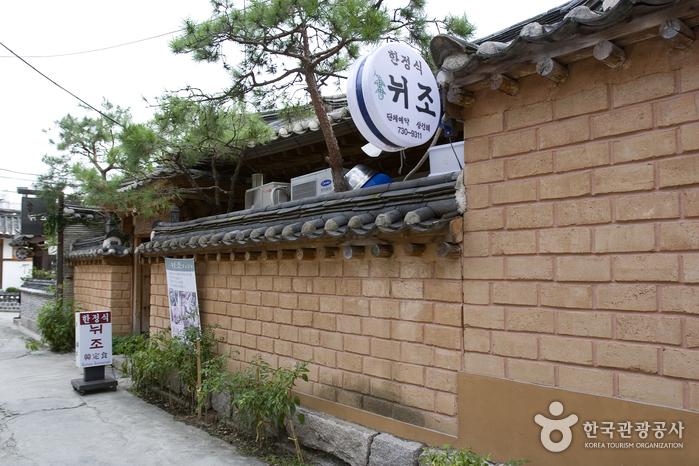
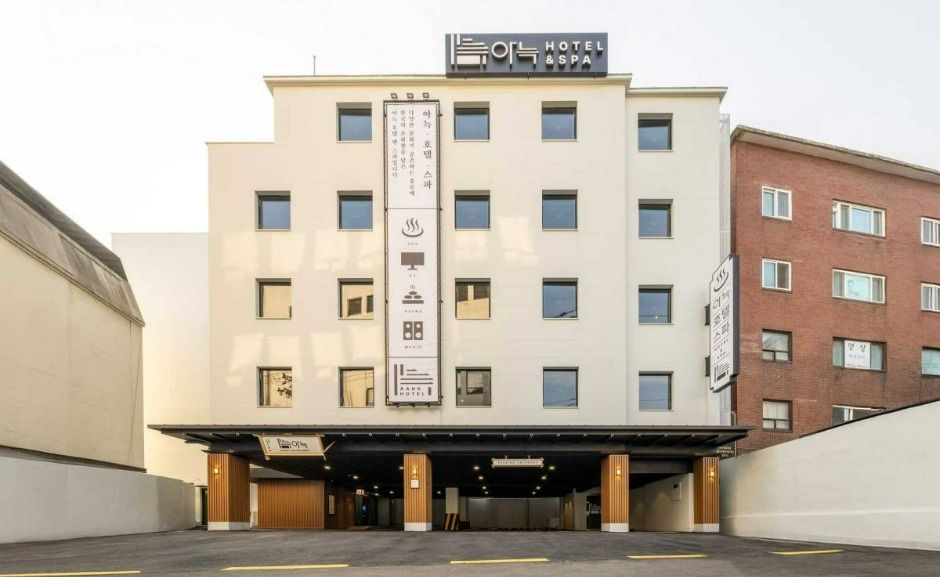
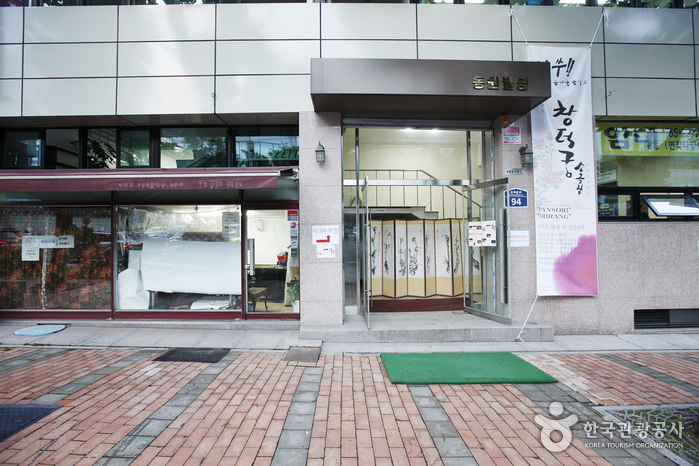
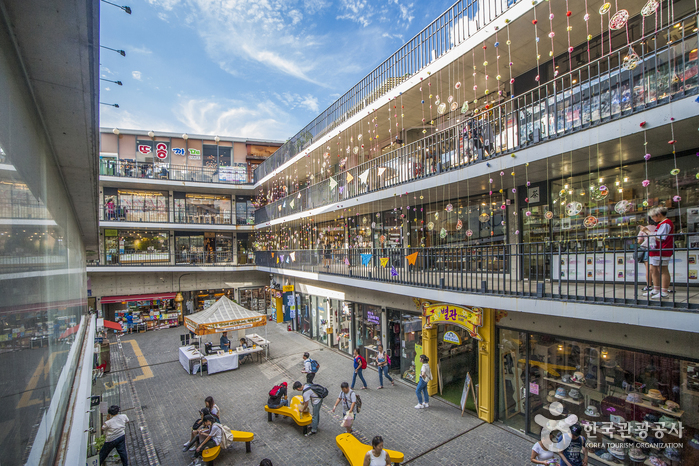
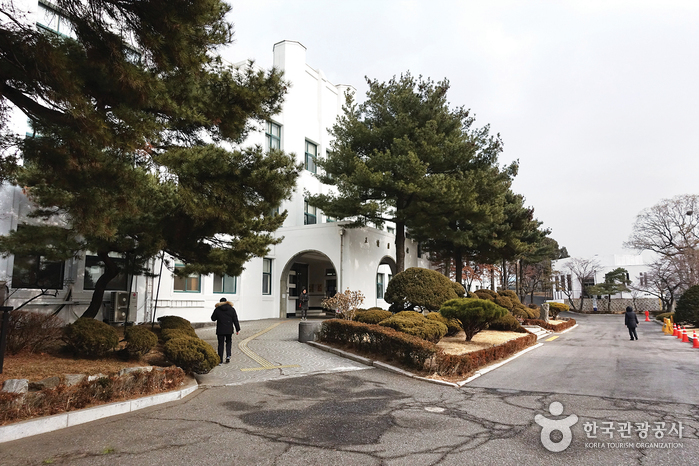
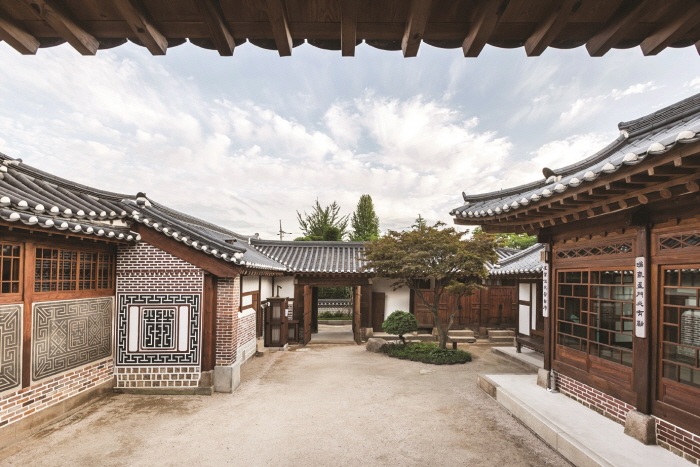
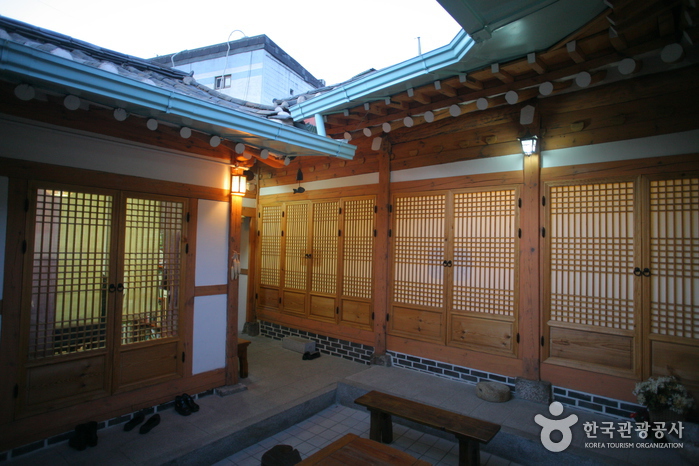
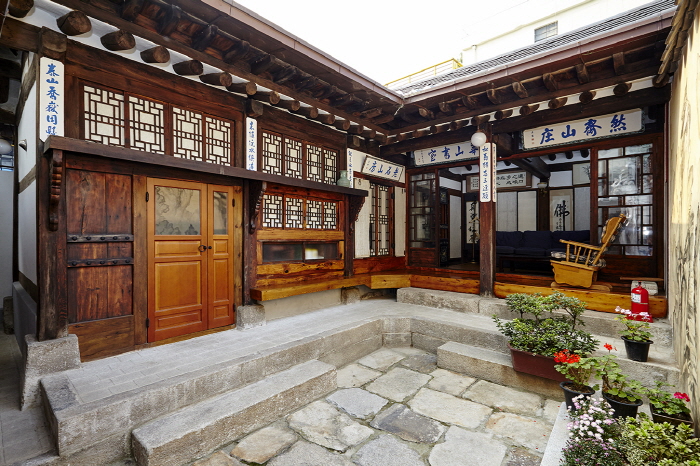
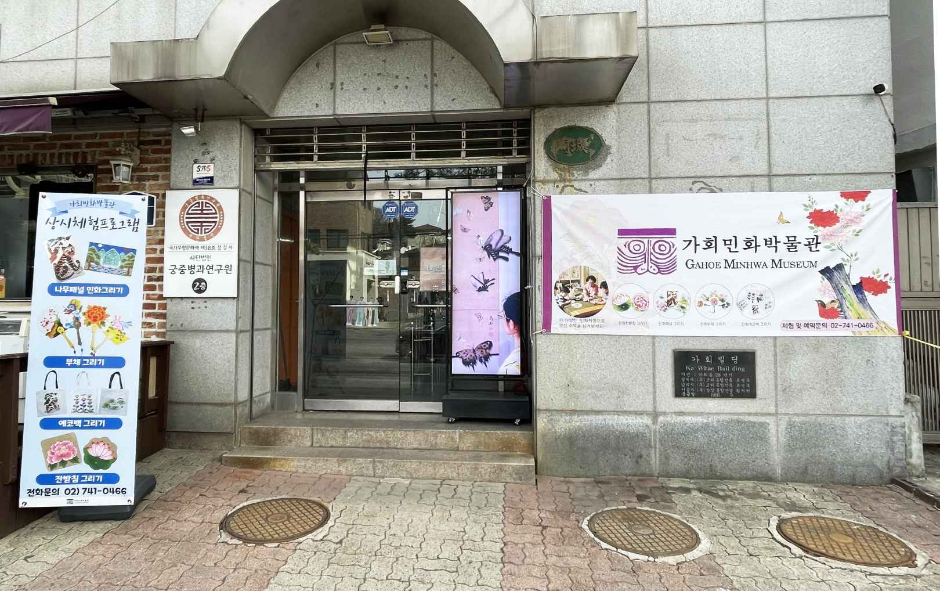
 Français
Français
 한국어
한국어 English
English 日本語
日本語 中文(简体)
中文(简体) Deutsch
Deutsch Español
Español Русский
Русский